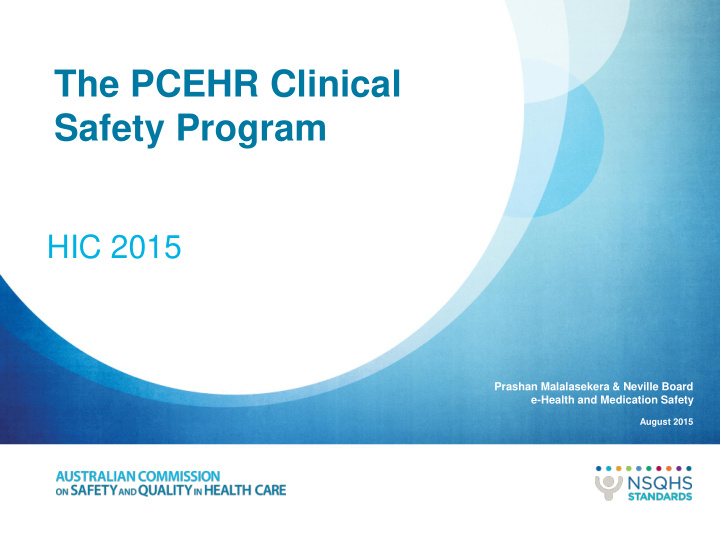



The PCEHR Clinical Safety Program HIC 2015 Prashan Malalasekera & Neville Board e-Health and Medication Safety August 2015
PATIENT SAFETY Health IT safety PCEHR clinical safety program
PATIENT SAFETY RACGP Safety in healthcare is reducing the risk of unnecessary harm to an acceptable minimum level. Patient safety is the freedom from hazards due to medical care or medical error in the general practice setting and is considered to be one of the dimensions of the quality framework for general practice. Harm can arise in healthcare, by omission or commission, and from the environment in which the healthcare is carried out. (1) IOM “freedom from accidental injury,” (2) NPSA ““[t]he avoidance, prevention, and amelioration of adverse outcomes or injuries stemming from the process of care.” (3) 1. RACGP curriculum, http://curriculum.racgp.org.au/statements/quality-and-safety/ 2. Emanuel L et al, AHRQ, What exactly is patient safety? (undated) http://www.ahrq.gov/professionals/quality-patient-safety/patient-safety-resources/resources/advances-in-patient-safety-2/index.html 3 Vincent C. Patient safety. London: Elsevier; 2006.
Adverse events occurred in 3.7 percent of the hospitalizations (95 percent confidence interval, 3.2 to 4.2), and 27.6 percent of the adverse events were due to negligence (95 percent confidence interval, 22.5 to 32.6). Although 70.5 percent of the adverse events gave rise to disability lasting less than six months, 2.6 percent caused permanently disabling injuries and percent led to death.
HOSPITAL SAFETY SYSTEMS Incident reporting systems Chart audit Bedside audits Mortality audit Data analyses Structure and system audits
Health IT safety Health Affairs , 30, no.3 (2011):464-471
Health IT and Clinical Safety • Widespread of adoption of clinical health IT systems has the potential to address some critical clinical safety issues that occur regularly • As evidence and research into health IT adoption grows there is acknowledgement of potential new risks introduced • Proactive clinical safety monitoring and surveillance of health IT systems is important in protecting against these risks.
PCEHR Safety Program In July 2012, the Department of Health appointed the Commission to manage a PCEHR safety program to: • Coordinate and manage a Clinical Governance Advisory Group (CGAG) for the PCEHR, to provide clinical safety advice and guidance to the PCEHR System Operator • Perform a series of clinical safety reviews on aspects of the PCEHR system • Conduct independent reviews of clinical incidents reported by the PCEHR System Operator • Provide expertise in consultations on new release development and to support best practice approaches to clinical safety and quality
Clinical Safety Layers in the PCEHR System Operator/End Users - day Commission PCEHR Safety to day monitoring and reporting of Program potential or actual clinical safety issues NEHTA CSU NEHTA CSU – expert advisors to the System Operator and users on clinical safety issue mitigation and System resolution Operator/End Users Commission – independent oversight and ability to provide expertise and support to the SO and NEHTA on clinical safety issues when requested.
Commission PCEHR clinical safety program Clinical safety reviews Independent PCEHR Proactive Incident surveillance of Clinical investigations PCEHR (London Safety Helpline calls Protocol) Assurance Development of a Clinical Incident Management Framework
PCEHR Safety Program – Clinical Safety Reviews Supports early identification of potential clinical safety risk areas and to recommend enhancements to guard against these risks. 4 reviews completed since July 2012, with a fifth underway http://www.safetyandquality.gov.au/our-work/safety-in-e-health/ Reviews have focused on: Incident Continuous Management and PCEHR Content Assessment Clinical Governance • Clinical safety • Medications • Acceptance and management tools Information implementation of • Discharge previous recommendations Summaries
PCEHR Safety Program – Incident Reviews and Clinical Incident Management Framework (CIMF) • The Commission has conducted two incident reviews at the request of the System Operator. • Incident reviews are conducted using the London Protocol methodology • Findings and recommendations are provided to the System Operator for system and process enhancements. • The Commission is developing a Clinical Incident Management Framework for the PCEHR System Operator
PCEHR Safety Program – Surveillance of PCEHR Helpline calls • The Commission, together with the Australian Patient Safety Foundation (APSF) reviewed 150 calls logged with the PCEHR Helpline in 2014/15. • The purpose was to identify any potential clinical safety risks/issues that may not have been classified accordingly. • Findings have indicated that no clinical safety risks/issues were present in the calls analysed and that the Helpline is unlikely to be used to register such matters by PCEHR users
PCEHR Safety Guidance – PCEHR Safe Use Guides • The Commission is developing guides for clinicians and consumers to promote the clinically safe use of the PCEHR system. • Guides to be based on US Safer Guides , tailored to PCEHR context. • The Guides aim to support surveillance for known health IT safety risks, with checklists of potential actions clinicians and users can undertake to guard against these risks
THANK YOU Contact: Prashan Malalasekera, Project Manager, e-Health and Medication Safety prashan.malalasekera@safetyandquality.gov.au
Recommend
More recommend